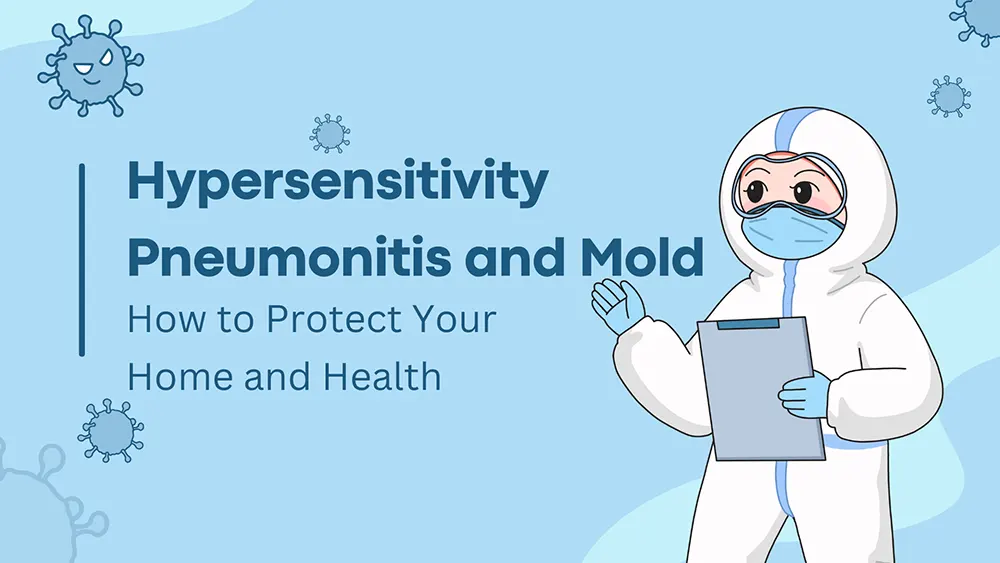Hypersensitivity pneumonitis is a serious lung condition caused by repeated exposure to environmental contaminants, and mold is one of the most common culprits. This inflammatory disease affects the lungs, leading to breathing difficulties and long-term respiratory complications. Because mold spores are microscopic airborne particles, they can easily infiltrate indoor spaces and trigger an immune system overreaction, causing swelling in lung tissue and reducing oxygen flow.
Mold exposure is often overlooked until symptoms become persistent, making early detection and remediation essential for preventing severe lung damage. Homeowners may experience mild reactions at first, such as coughing or fatigue, but without intervention, hypersensitivity pneumonitis can progress into chronic respiratory illness.
This guide explains how mold contributes to lung inflammation, the warning signs to watch for, and the best strategies to eliminate mold contamination to ensure a healthy indoor environment.
Protect Your Health—Schedule Your Free Mold Inspection Today in Long Island, The Bronx, Brooklyn, and Queens!
Early Symptoms of Mold-Related Hypersensitivity Pneumonitis
Early symptoms of mold-related hypersensitivity pneumonitis often mimic common respiratory issues, making them easy to overlook. However, continued exposure to airborne mold spores can cause persistent discomfort and lead to more serious complications.
Individuals may experience mild symptoms initially, such as a lingering cough or shortness of breath, which can escalate into chronic lung inflammation if mold contamination is not addressed. Recognizing the early signs of mold-related respiratory distress is crucial for preventing long-term health risks.
Here are the signs of mold-related hypersensitivity pneumonitis:
- Shortness Of Breath: Occurs after exposure to mold spores, often mistaken for seasonal allergies or mild asthma.
- Dry, Persistent Cough: A lingering cough with no clear cause, worsened by time spent indoors.
- Fatigue And Weakness: Mold-related inflammation reduces oxygen intake, leading to persistent tiredness.
- Low-Grade Fever And Chills: The immune system responds to mold toxins, mimicking flu-like symptoms.
Chronic Symptoms From Long-Term Mold Exposure
Severe Breathing Difficulties: Lung inflammation restricts airflow, making normal activities harder.
- Chest Tightness And Wheezing: Persistent irritation causes bronchial constriction and restricted lung expansion.
- Long-Term Lung Scarring: Prolonged exposure leads to fibrosis, reducing lung capacity and increasing susceptibility to infections.
- Increased Risk Of Respiratory Failure: In advanced cases, mold-related hypersensitivity pneumonitis may require medical intervention to manage worsening lung conditions.
If you suspect mold exposure is affecting your breathing or worsening existing lung conditions, taking action early is essential for preventing lasting damage.
How Mold Triggers Hypersensitivity Pneumonitis – The Science Explained
Mold exposure triggers immune system hypersensitivity, causing inflammation in lung tissues and leading to potentially permanent respiratory complications. When airborne mold spores enter the lungs, the immune system mistakenly identifies them as dangerous pathogens and launches an aggressive response. This inflammatory reaction can cause swelling in the airways, increased mucus production, and restricted oxygen flow.
For individuals with hypersensitivity pneumonitis, repeated exposure to mold contaminants can worsen lung function over time. Toxic mold varieties, including black mold, release harmful mycotoxins that irritate lung tissue, contributing to progressive scarring and fibrosis. These microscopic toxins embed deep within the respiratory system, making recovery more difficult without professional intervention.
Over time, mold exposure leads to chronic inflammation, leaving affected individuals with persistent breathing difficulties and an increased risk of respiratory infections. Without proper mold removal, hypersensitivity pneumonitis can escalate into long-term lung disease.
The Dangers of Hypersensitivity Pneumonitis If Left Untreated
Without intervention, hypersensitivity pneumonitis can cause irreversible lung scarring, leading to chronic breathing difficulties and reduced quality of life. Mold exposure—particularly in indoor environments with high humidity, poor ventilation, or hidden mold growth—can significantly worsen the condition.
Long-Term Risks of Untreated Mold Exposure
- Permanent Lung Scarring: Ongoing inflammation can lead to fibrosis, making it harder for the lungs to expand properly.
- Chronic Shortness of Breath: Lung damage reduces oxygen absorption, making everyday activities more exhausting.
- Progressive Lung Disease: Left untreated, mold-related inflammation may develop into serious respiratory illnesses, including chronic obstructive pulmonary disease (COPD).
- Increased Risk of Respiratory Failure: Severe cases may require oxygen therapy or long-term medical management.
The longer mold contamination persists, the greater the risk of lasting lung damage. Early mold remediation is the most effective strategy for preventing complications and protecting respiratory health.
Why Mold Removal Experts Provides the Best Protection Against Mold Exposure
At Mold Removal Experts, we specialize in comprehensive mold remediation and air quality solutions, ensuring your home remains safe and breathable for years to come. Our targeted approach eliminates hidden mold infestations, stops future contamination, and enhances indoor air quality for those vulnerable to respiratory conditions.
Our Mold Remediation and Air Quality Services
- Encapsulation for Long-Term Mold Prevention: Seals contaminated areas to prevent future mold growth.
- Basement Waterproofing and Drainage Systems: Eliminates moisture buildup in high-risk areas.
- High-Performance Dehumidifiers: Lowers humidity levels to stop mold from spreading.
- Advanced Air Filtration Solutions: Uses HEPA filters to trap airborne mold spores.
- Comprehensive Mold Inspections and Testing: Identifies and removes mold at the source.
For those exposed to hypersensitivity pneumonitis-related mold risks, expert remediation ensures that indoor air remains safe and mold does not return.
Final Thoughts – Hypersensitivity Pneumonitis and Mold
Hypersensitivity pneumonitis caused by mold exposure is a serious health risk—but professional mold remediation can eliminate the threat, restore indoor air quality, and protect your home and health. Mold contamination does not go away on its own, and delaying remediation can lead to lasting respiratory damage. Investing in expert mold removal, waterproofing solutions, and air filtration helps prevent exposure and ensures safer indoor conditions.
Restore Your Air Quality and Health—Schedule Your Free Mold Inspection Today!

